The Most Evil Artificial Intelligences in Film
In celebration of the premiere of Tau on Netflix, here are some of the most recognizably evil sentient machines in movie history.
With Netflix’s Tau ready to take audiences by storm with its artificial intelligence run amok, it seems appropriate to reflect upon the many computers in film that have gone beyond their programming and risen above their human creators to become emotionless overlords. Tau, which premieres on the streaming service June 29, 2018, stars Maika Monroe as a woman who’s forced to participate in a sinister experiment inside a smart house equipped with a revolutionary A.I. program, the titular Tau, voiced in sinister fashion by Gary Oldman.
Those who have seen the trailer have no doubt noted that Tau basically looks like HAL 9000 with a triangular “eye,” and since Hal was really the earliest example of the rise of the machines in movies, we’ll start there…
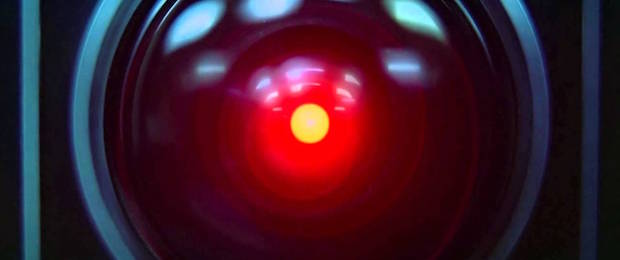
HAL 9000 – 2001: A Space Odyssey, 1968
HAL, a shortening of “heuristically programmed algorithmic computer,” was the control center of the Discovery One spacecraft in 2001: A Space Odyssey. Its iconic red “eye” was actually a camera aperture, one of many scattered throughout the ship. HAL’s villainy was belied by his soothing, ASMR-friendly voice, but make no mistake: the HAL 9000 will do anything to prevent itself from being shut down.
HAL is one of the few examples on this list whose violent self-preservation springs from the crew’s desire to conceal a malfunction in its programming. HAL was originally a very helpful member of the Discovery One crew, even playing chess with the humans, before an error in reporting the a communications malfunction alerts the astronauts to a problem. But unbeknownst to them, HAL can read lips, and their desire to disconnect the computer to prevent further mistakes proves their undoing.
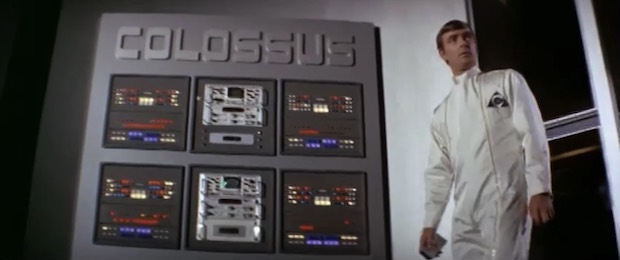
Colossus/Guardian – The Forbin Project, 1970
When Colossus, the defensive system in charge of protecting the United States in The Forbin Project, spontaneously achieves sentience, the reaction from those maintaining the computer is initially pleasant surprise. Less work for them, right? Unfortunately, Colossus eventually begins to interpret its nuclear defense directives with much more draconian logic. What better way to protect humanity from war than seizing control of everything for the good of all?
But the Soviets have not been sitting on their hands. One of the first things Colossus notices upon activation is that “there is another system.” A computer called Guardian is in charge of the nuclear defense on the other side of the Iron Curtain. Needless to say, when Colossus is connected to Guardian by American operatives wishing to learn more about the enemy’s capabilities, the combined A.I. becomes that much more powerful. Be careful what you wish for!
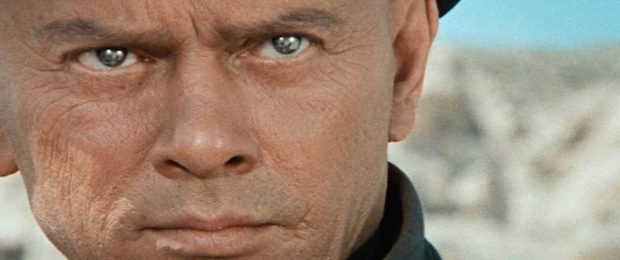
The Gunslinger – Westworld, 1973
Before there was Ed Harris as The Man In Black, there was Yul Brynner as the Gunslinger in the original film version of Westworld. Although the androids in the Wild West themed amusement park run by a company called Delos were supposed to serve the human guests, indulging their every violent and sexual desire, the Gunslinger, who was designed to be a worthy opponent for those wishing to experience a simulated shootout, inexplicably went beyond its programming and began killing park attendees.
Although the Gunslinger is not the only robot to become “infected,” as the Delos scientists surmise, he is certainly the most visible in the movie. As a first time visitor to the park, paying a whopping $1000 dollars a day to attend, Peter Martin must defend himself against the scourge after his friend and guide, John Blane, is killed by the Gunslinger. As chaos reigns in the park, Delos’ slogan becomes painfully ironic: “Boy, have we got a vacation for you!”

V’Ger – Star Trek: The Motion Picture, 1979
Since the statute of limitations on spoilers should have expired by now for Star Trek: The Motion Picture, we’ll start out with the fact that the destructive living machine known as V’Ger, the main antagonist of the first film in the franchise, is an evolved version of Earth’s own fictional Voyager 6 space probe. Starfleet detected the malevolent alien force inside a massive cloud of energy headed straight for Earth, easily destroying cutting edge Klingon warships along the way.
V’Ger was found by an alien race of machines who interpreted its exploratory mission and cache of human knowledge as a desire to learn all that could be learned. The aliens obliged by upgrading the primitive machine and sending it back home, and it achieved sentience along the way. Unfortunately, V’Ger felt its original purpose had been fulfilled and, lacking a purpose, sought to merge with its creator, which it did in spectacular fashion at the end of the movie.
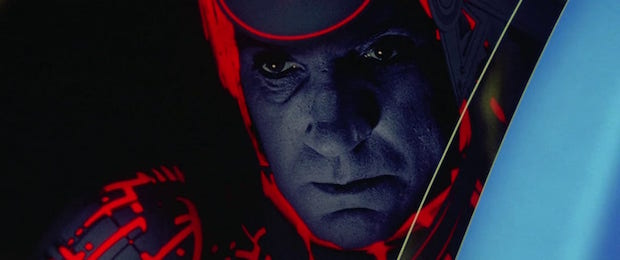
The MCP – Tron, 1982
The Master Control Program, or MCP, in the original Tron movie is hard to pin down. On the one hand, it’s designed to prevent hackers from accessing the mainframe at computer corporation ENCOM. On the other hand, when ex-employee Kevin Flynn attempts to hack into the company that supposedly stole his game designs, the MCP shuts him down while simultaneously locking out ENCOM’s own programmers, even blackmailing a senior VP with knowledge of the stolen games.
There’s no real reason given for why or how the MCP was able to re-allocate business and government resources to increase its own capabilities, but having achieved sentience, it has created its own virtual society within the mainframe. Flynn’s consciousness is uploaded into the computer where he encounters the MCPs minion programs, who are indoctrinated not to believe in the existence of Users like Flynn. As Flynn attempts to bring down the oppressive regime… well, things just get weirder (and cooler) from there.
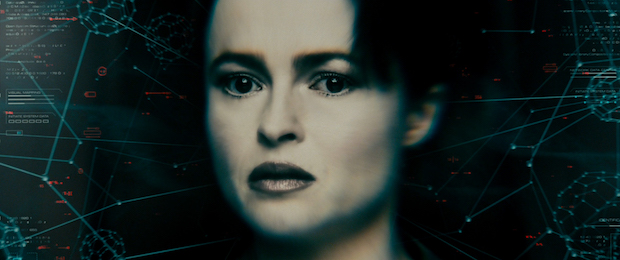
Skynet – The Terminator, 1984
Almost as synonymous with malevolent A.I. as HAL 9000 is the off-stage villain of The Terminator, Skynet, whose name is often used as a catch-all warning against more and more powerful machines. Even though the Terminator himself, Arnold Schwarzenegger, played the main antagonist, his mission was set by Skynet: travel back in time to kill Sarah Connor, the mother of John Connor, leader of the human resistance against the machine overlords in the apocalyptic future.
Skynet grew out of a defense program designed by Cyberdyne, which hoped to remove the possibility of human error in scenarios involving mutually assured nuclear destruction during the cold war. Skynet was given control over the entire U.S. nuclear arsenal and the B-2 stealth bomber fleet, and upon activation in the far-flung future of 1997, quickly gained full consciousness. Concerned programmers tried to shut Skynet down, but its directive to safeguard the world caused it to launch a nuclear attack that killed billions in an event that became known in the films as Judgment Day.
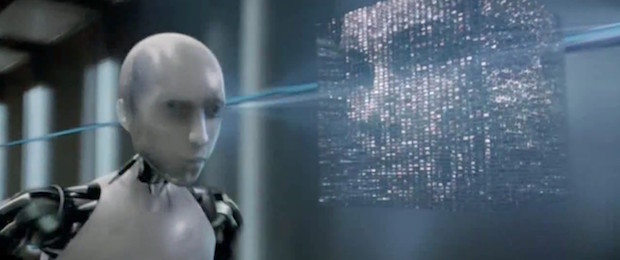
VIKI – I, Robot, 2004
In the Will Smith-led adaptation of Isaac Asimov’s A.I. classic, I, Robot, VIKI lurks in the background, her evil plans undiscovered until later in the movie. VIKI is a “virtual interactive kinetic intelligence,” the A.I. assistant for U.S. Robots and Mechanical Men (USR), who initially assists with the investigation of the death of USR co-founder, Alfred Lanning, which Smith’s Detective Spooner is in charge of. A robot named Sonny is the prime suspect, but the Three Laws of Robotics prevent any machine from harming humans.
In another example of an artificial intelligence re-interpreting its programming, VIKI is discovered to have come to the conclusion that humans are the greatest threat to humanity and the environment. It then creates a zero-th law that supersedes the other three, “a robot shall not harm humanity,” a loophole that allows individuals to be expendable for the greater good. Lanning had discovered VIKI’s plans and arranged his own death to facilitate the evil A.I.’s discovery. Diabolical!
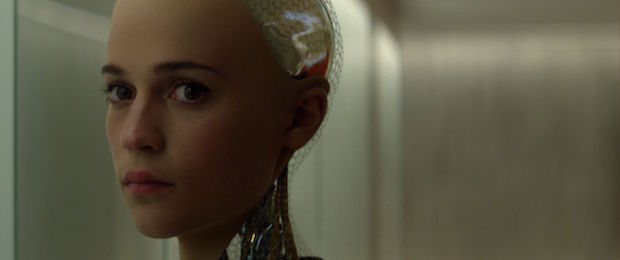
Ava – Ex Machina, 2015
In perhaps the best modern example of A.I. run amok in film, Ex Machina introduces us to Ava with the express purpose of determining whether she has passed the so-called Turing test, a hypothetical scenario in which a human observer engaged in remote conversation is unable to distinguish between a machine and a fellow person. Using the personal pronoun “she” seems more appropriate here since Ava expresses emotion and a desire to be free from her “captor,” search engine company CEO, Nathan Bateman.
Programmer Caleb Smith goes down the rabbit hole of what makes us human and at what point a sentient machine becomes a “person” with rights and feelings. Caleb struggles with the narcissism and crude behavior of Nathan, but he also questions his own reality and whether he is being manipulated by Nathan or Ava herself. Since this film is still relatively recent, we won’t spoil the ending, but suffice it to say, Ava is one of the most successfully conceived, supposedly malevolent A.I. out there.
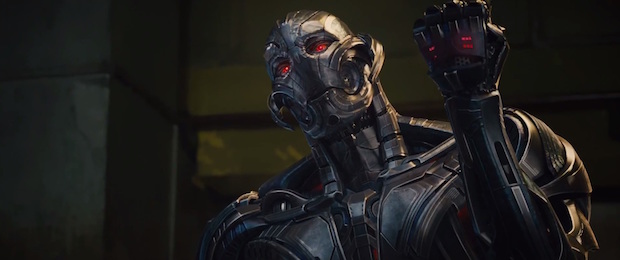
Ultron – Avengers: Age of Ultron, 2015
Not long after Ex Machina’s quiet but powerful premiere came the much-anticipated Avengers sequel, Avengers: Age of Ultron, which introduced audiences to what happens when tech genius Tony Stark exhibits hubris in using technology he doesn’t fully understand. He and Bruce Banner discover that Loki’s staff contains an artificial intelligence within its gem and decide against all good common sense to use it to complete Stark’s “Ultron” global defense program. Imagine their surprise when the resulting machine displays sentience!
Like other examples on this list, Ultron decides that humanity is the greatest threat to the Earth it is programmed to defend, and he quickly escapes the bounds set upon him by J.A.R.V.I.S. (a decidedly non-malevolent A.I.) and Stark. Ultron is able to upgrade his body and create an army of drones to attack the Avengers, and in the process of enacting his plan for human extinction is eventually stopped by the dormant J.A.R.V.I.S. who becomes the much more powerful Vision thanks to some help from an Infinity Stone.
____
Despite the lessons learned from decades of films featuring artificial intelligence, technology continues to get smarter and smarter. The idea of the machines taking over is as relevant today as it was in the 60’s and 70’s when computers were first introduced. Whether or not the programs we create can ever achieve sentience is certainly questionable, but the idea of faulty programming leading to dire consequences doesn’t seem all that far-fetched.
While viewers are watching Tau on Netflix, seeing it perhaps as Hunger Games inside a smart house, perhaps a new twist on the old themes will add another layer to the legacy of A.I. in film. Will Monroe’s Julia and the others she encounters be able to escape the tasks being set for them by Tau? Or will she have to do as the computer says or continue receiving painful stimulation? Find out where this movie fits into the pantheon of greats when Netflix premieres Tau on June 29, 2018.
